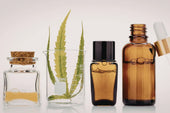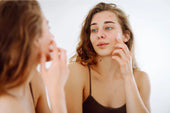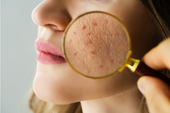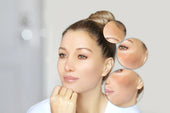Skincare Must-Haves For Every Age - Real Advice, Real Results
Botanic Essentials
Share
A decade-by-decade plan for skincare helps you pick the right why, what, and how - not just trendy products. Sometimes, you might wonder whether to continue with your current skincare or if it’s time to switch things up. Let’s check out this practical guide on the “must-haves” products or ingredients for every age, why they work, and how to use them, plus reliable studies to back it up.
Quick Overview: Across every age, whether you are in your 20s, 30s, 40s, or 50+, the non-negotiables are a gentle cleanser, an effective daily sunscreen, and a basic moisturiser. From there, you layer age-appropriate actives (Antioxidants, exfoliants, Bakuchiol, humectants, richer emollients) depending on your skin goals and tolerance.
How Skin Changes with Age (A Bigger Picture)
Skin aging is driven by two major factors:
- Intrinsic aging — The genetics, slower cell turnover, collagen loss, and thinning skin are the main contributing factors.
- Extrinsic aging — Primarily sun/UV exposure, pollution, smoking, lifestyle; this causes photoaging (wrinkles, pigmentation, laxity).
Basics for Every Age
- Gentle cleanser — Removes dirt, oil, and impurities without stripping lipids.
- Moisturiser - It is a key treatment/support for multiple skin issues. The moisturiser maintains the skin barrier, reduces transepidermal water loss, soothes, and improves skin texture.
- Sunscreen (SPF ≥30) - carry it with you daily. Apply every morning and reapply whenever you spend extended time outdoors.
Patch testing & sun safety — Introduce one active at a time, patch test new products, and be careful or consult a doctor if pregnant or breastfeeding, before testing new products.
By Decade — What to Prioritize, Why, and How to Use It?
20s — prevention + control (oil, acne, early photo damage)
In your 20s, your skin is finding its rhythm - but it can still throw a few curveballs. Many people deal with hormonal breakouts, lingering acne, or early signs of sun damage that lead to dullness and uneven skin tone. This is the decade to protect, balance, and set up a solid foundation for the years ahead.
Must-haves
- Gentle Cleanser - Use twice daily for normal, oily, or acne-prone skin to remove impurities without stripping natural oils.
- Lightweight Moisturiser -Choose a moisturiser with ceramides and niacinamide to strengthen the skin barrier without clogging pores; niacinamide also helps reduce redness and fade pigmentation.
- Daily SPF 30+ (broad spectrum) - Establish sun protection habits early to prevent future photoaging, apply every morning.
- Targeted Acne Treatment (If required) - Look for salicylic acid- It treats active lesions and prevents post-inflammatory pigmentation/scarring.
How to use
- AM: Gentle Cleanser → Moisturizer → Sunscreen.
- PM: Cleanser → Acne treatment, salicylic acid (if acne) → Moisturiser.
What to expect: Protecting the skin barrier and prevention of long-term sun damage.
30s — Collagen Decline Appears; Fine Lines & Pigmentation
In your 30s, fine lines start to appear, skin begins to lose firmness, and signs of sun damage and pigmentation become more noticeable.
Must-haves
Cleansers:
- Hydrating Cleanser - If your skin feels drier or tighter.
- Gel Cleanser (Non-Stripping) - Great for combination or oily skin.
- Cleansing Balm or Oil - Perfect for removing sunscreen and makeup.
- Enzyme or Lactic Acid Cleanser - Helps refine texture and fade early pigmentation.
- Antioxidant Serum (Vitamin C) - It will help protect from free radical damage and brighten pigment.
- Moisturiser with hyaluronic acid + ceramides - Hydrates and plumps superficial lines. Hyaluronic acid serums measurably increase hydration.
- Daily SPF 30+ -Apply every morning after serum and moisturiser —sunscreen remains the #1 anti-aging essential.
- Topical Bakuchiol - Use Bakuchiol at very low strength to start. It is proven to reduce fine lines, improve texture, and pigmentation over time. Start slowly and use it at night.
How to use
Introduce Bakuchiol gradually: 1–2 nights/week → increase as tolerated; use moisturizer to buffer irritation. Follow sun protection during daytime
What to expect: Smoother texture, reduced fine lines over months (Bakuchiol take ~12 weeks to show visible changes, more improvement by 6–12 months).
40s — Deeper Lines, Loss of Elasticity, Beginning Volume Changes
In your 40s, skin renewal slows noticeably, leading to deeper lines, loss of elasticity, and dryness. Pigmentation and redness become more visible as collagen production declines. This is the time to focus on nourishment, barrier repair, and firming skincare.
Must-Haves
- Gentle Cream or Oil Cleanser – Protects the skin barrier and prevents further dryness.
- Hydrating Toner or Essence – Replenishes moisture and preps skin for better absorption.
- Antioxidant Serum (Vitamin C, E, or CoQ10) – Fights pigmentation and boosts brightness.
- Bakuchiol Serum – Stimulates collagen to reduce wrinkles and improve firmness.
- Rich Moisturiser with Ceramides & Hyaluronic Acid – Locks in hydration and strengthens the barrier.
- Eye Cream with Caffeine – Targets fine lines and puffiness.
- Broad-Spectrum SPF 30+ – Daily protection to prevent further sun damage and age spots.
How to Use
- AM- Cleanser → Antioxidant Serum → Moisturiser →Sunscreen
- PM- Apply Bakuchiol → wait (or use “sandwich” method with moisturizer) → richer night cream. Use Bakuchiol 1-2 times per week.
50s — Hormonal Changes, Thinning Skin, Increased Dryness
In your 50s, post-menopausal skin changes can accelerate thinning, dryness, and loss of collagen and natural oils. Wrinkles and sagging become more pronounced, while pigmentation and sensitivity may increase. Skincare should focus on deep hydration, nourishment, and restoring elasticity.
Must-Haves
- Rich, Creamy Cleanser – Gentle cleansing without stripping essential oils.
- Hydrating Toner or Essence – Boosts moisture and prepares skin for serums.
- Serums with Bakuchiol, or Growth Factors – Supports collagen and elasticity.
- Antioxidant Serum (Vitamin C or E) – Protects against free radicals and brightens skin.
- Deeply Nourishing Moisturiser – With ceramides, hyaluronic acid, or squalane to restore the barrier.
- Eye Cream with Hyaluronic Acid – Targets fine lines and puffiness.
- Broad-Spectrum SPF 30+ – Daily sun protection to prevent further damage.
- Facial Oil – Adds extra nourishment and helps replenish lost natural oils.
How to use
- AM: Cleanse → Hydrating toner/serum → Moisturiser → Eye cream → SPF.
- PM: Cleanse → Toner/serum (Bakuchiol/Bidens Pilosa) → Moisturiser → Eye cream → facial oil.
What to expect: Improved hydration and texture; structural changes (volume loss) may persist without procedural support.
60s and Beyond — Fragile, Thin, Very Dry Skin; Healing Slower
In your 60s, skin becomes thinner and more fragile, showing pronounced laxity, deep wrinkles, and noticeable sagging. Bruising occurs more easily, and wound healing slows down due to reduced collagen and elastin. Sun damage accumulates, making pigmentation, age spots, and actinic keratoses more common. Hydration, barrier support, and gentle care are essential, while regular skin checks become increasingly important. Skincare should focus on nourishing, protective, and repairing ingredients to maintain resilience and comfort.
Must-Haves
- Ultra-Gentle Cleanser – Maintains the skin barrier without irritation.
- Hydrating Toner or Essence – Boosts moisture and preps skin for treatments.
- Serums with Growth Factors, or Bakuchiol – Supports collagen and skin repair.
- Rich, Nourishing Moisturiser – With ceramides, hyaluronic acid, or squalane to deeply hydrate and strengthen the barrier.
- Eye Cream with Hyaluronic Acid – Reduces fine lines and maintains delicate eye area hydration.
- Broad-Spectrum SPF 30+ – Daily sun protection to prevent further damage.
- Facial Oil – Adds extra nourishment for very dry or delicate skin.
- Gentle Exfoliants (Optional, 1–2x/week) – Mild lactic acid or enzyme-based exfoliants to improve texture and radiance.
Regular Skin Checks: Increased risk of pre-cancerous/baseline lesions; see a dermatologist or GP for suspicious spots. (Follow local NZ guidance for sun safety and skin checks.)
- AM: Gentle cleanser → Hydrating toner/serum → Rich moisturizer → Eye cream → Broad-spectrum SPF.
- PM: Gentle cleanser → Toner/serum (Bakuchiol) → Rich moisturizer → Eye cream → facial oil
Practical Tips & Safety
- Introduce one new active at a time and wait 2–4 weeks to observe reactions.
- Patch test new products on the inner forearm.
- If using strong actives, ramp up slowly and use moisturizers to buffer irritation.
- Pregnancy/breastfeeding: avoid retinoids and some other prescription agents — consult your clinician before trying new products/ingredients.
Sun protection combined strategies: clothing, shade, SPF 30+ sunscreen, and reapplication are recommended — New Zealand health guidance also emphasizes practicing UV-aware behavior to protect your skin.
What Results to Expect (Timeline)
- Sunscreen & antioxidants: Reduce cumulative damage and slow future aging — benefits accumulate over the years.
- Bakuchiol: Initial irritation is common; visible improvement in texture/pigmentation in ~12 weeks, more substantial after 6–12 months.
- Moisturizers & HA: Immediate improvement in hydration and plumping of fine lines; barrier function improves over weeks.
Final Notes — How We’d recommend you use this Guide?
- Start with the basics: sunscreen + moisturizer + gentle cleanser.
- Pick one active to add (vitamin C in AM or Bakuchiol at night) and ramp up slowly.
- If you have specific concerns (severe acne, rosacea, suspicious lesions, rapid hair/skin changes), see a dermatologist — personal medical history matters.
- Be consistent: prevention (sunscreen & barrier protection) wins more than chasing aggressive fixes.
 is here! Shop now, pay later in 4 easy installments
is here! Shop now, pay later in 4 easy installments












